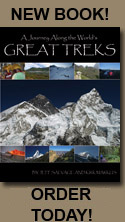 |
 |
Handling the Ups and Downs
 Treks are rarely flat. On the Everest Base Camp trek our guide dubbed the less steep sections of the trail as Nepalee Flat. Loosely translated, it meant flat for Nepal. You see there were no flat areas on the trail, just steep and less steep.
Treks are rarely flat. On the Everest Base Camp trek our guide dubbed the less steep sections of the trail as Nepalee Flat. Loosely translated, it meant flat for Nepal. You see there were no flat areas on the trail, just steep and less steep.
The key to successful trekking is to not overtax yourself charging an uphill. Your goal is to maintain your heart rate as much as possible. This usually means slowing down as you climb a steep grade and accelerating slightly on the down hills. However, it’s not just about speed; it’s about your stride.
When climbing a steep grade, imagine yourself like a bicycle rider. When climbing a hill, bikers switch gears into a mode that requires less effort. As trekkers we can accomplish the same by taking shorter quick strides. The shorter strides reduce the effort per stride. By increasing your turnover, you make up for some, but not all of the loss of stride length.
Here’s a simple test to illustrate the method’s effectiveness. Try running up a few flights of steps as fast as you can. Do it once leaping over two steps per stride and then try it one step at a time. You certainly can get up the steps quicker take two at a time (simulating longer strides) than one at a time (simulating shorter strides), but your breathing is much harder when the longer strides are taken.
oing down hill, the process reverses itself. Take longer strides, allowing the trail’s grade to help you along. For an added bit of speed, lead your lead with your hip. By swinging your hip forward with each stride, you extend your stride a few inches with each step and thus get added distance for almost no effort. Remember to use trekking poles to help absorb the stress of your body’s weight as it strikes the ground with greater force on the down hills.
